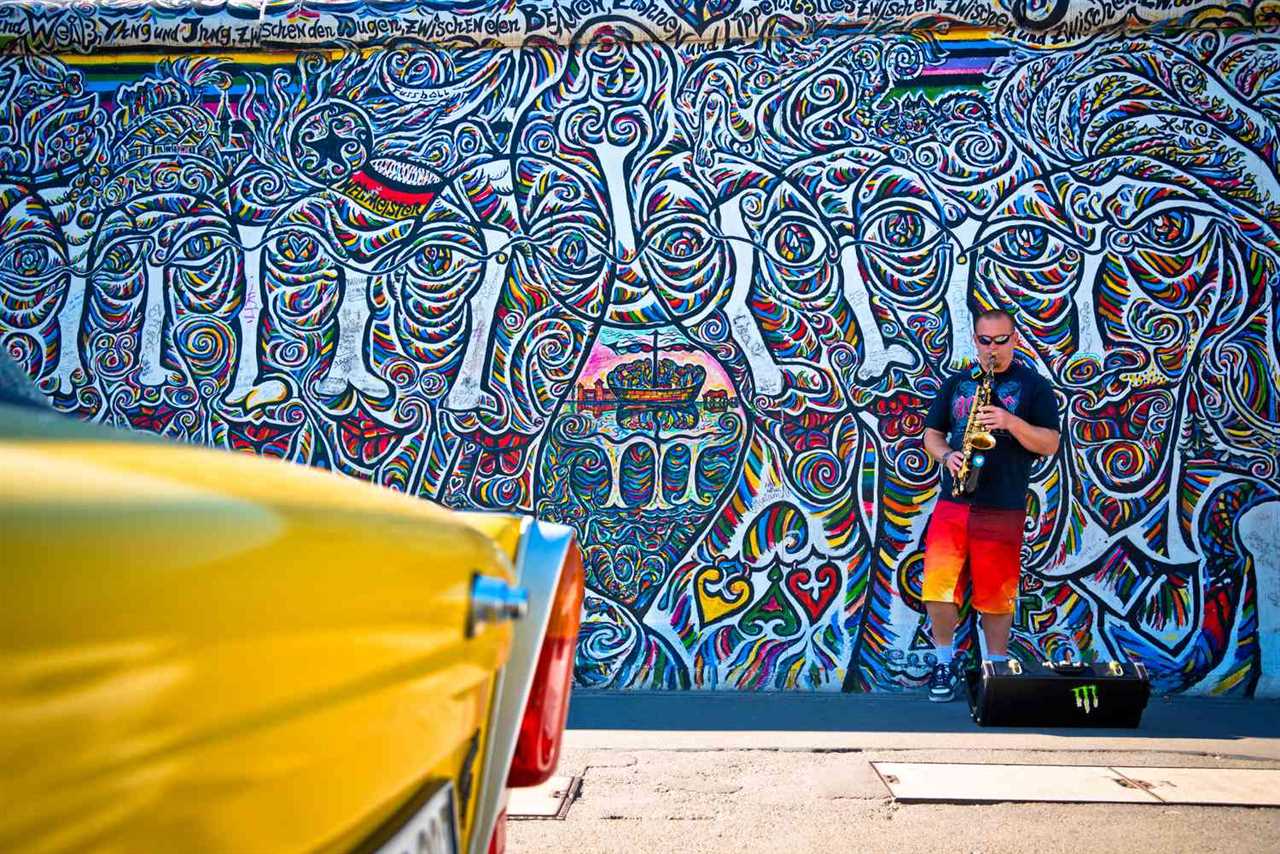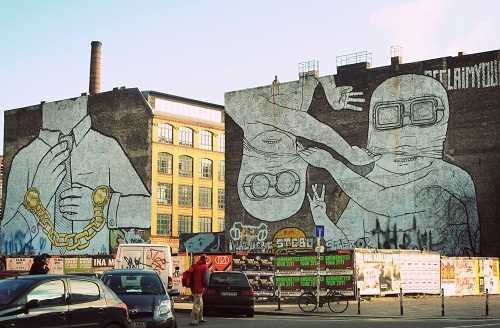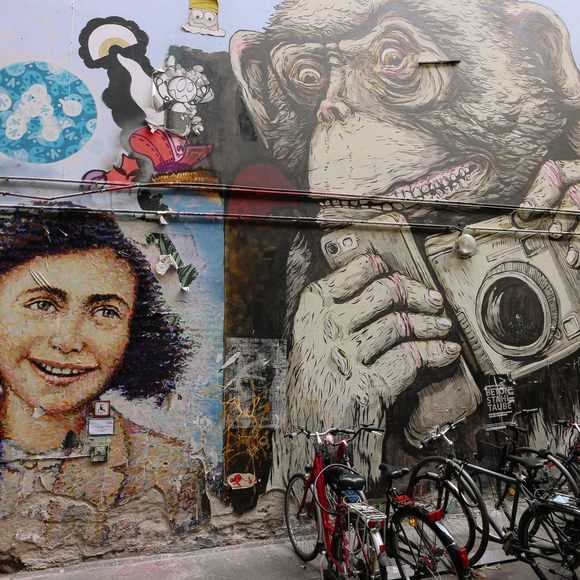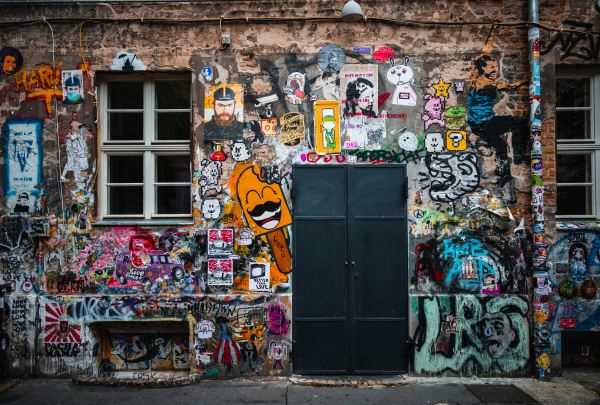
Berlin, the capital city of Germany, is known for its rich history, diverse architecture, and vibrant culture. One unique aspect of the city’s cultural landscape is its thriving street art scene. From colorful murals painted on building facades to thought-provoking graffiti, Berlin’s streets are a canvas for artists from all over the world.
Street art in Berlin is not just about artistic expression, it’s also a reflection of the city’s history and landmarks. Many of the murals depict iconic symbols and images that are significant to Berlin’s past. For example, you can find artwork that pays homage to the Berlin Wall, a tangible reminder of the city’s division and subsequent reunification.
Walking through the streets of Berlin, you’ll encounter an array of street art styles and techniques. Some artists create large-scale murals that cover entire buildings, while others prefer smaller, more intricate pieces. Each artwork tells a story, whether it’s a political statement, a social commentary, or simply a celebration of creativity.
What sets Berlin’s street art scene apart is its acceptance and appreciation by both the local community and the city’s government. Rather than being seen as vandalism, street art is embraced as a form of cultural expression. This has led to the establishment of legal graffiti zones and organized street art tours, where visitors can learn about the artists and their works.
Capturing the Essence of Berlin
Visiting Berlin is an exhilarating experience that immerses you in a city steeped in history, culture, and creativity. One of the best ways to truly capture the essence of Berlin is by exploring the vibrant street art scene that can be found throughout the city.
From the iconic East Side Gallery, with its large murals painted on segments of the Berlin Wall, to the hidden corners of Kreuzberg and Friedrichshain, every neighborhood in Berlin offers a unique canvas for artistic expression. The street art in Berlin is not just graffiti; it is a reflection of the city’s history, landmarks, and the people who call Berlin home.
Historical Reflections
Walking through the streets of Berlin, one can witness how street art has become an integral part of the city’s identity. Many murals and pieces pay homage to the German capital’s tumultuous past, reminding visitors of the division and reunification that shaped the city. These artworks serve as powerful reminders of the struggles and triumphs Berlin has witnessed throughout its history.
One notable example is the mural depicting the famous Trabant car bursting through the Berlin Wall. This artwork symbolizes the collapse of the Iron Curtain and the reunification of East and West Germany. It serves as a reminder of the resilience and unity of the people of Berlin.
Cultural Expressions

Berlin’s street art culture is also a reflection of its diverse and vibrant cultural scene. The artwork showcases the city’s open and inclusive nature, embracing artists from all backgrounds and styles. From large-scale murals to intricate stencils, each piece tells a unique story and contributes to the rich tapestry of Berlin’s artistic landscape.
Through street art, Berliners express their values, passions, and anxieties. Many pieces touch on political issues, social justice, and environmental concerns. Street artists use their work to spark conversations and engage the community in debates about important topics. This fusion of art and activism is a testament to Berlin’s spirit of freedom and individualism.
The street art in Berlin is constantly evolving and changing. It is not just about creating visually striking images but also about capturing the spirit of the city and its people. So, as you stroll through the streets of Berlin, keep an eye out for the hidden gems of street art that beautifully capture the essence of this dynamic and ever-changing city.
A Glimpse into Berlin’s Street Art Scene
Berlin’s street art scene is a vibrant and dynamic reflection of the city’s history and landmarks. From the iconic East Side Gallery to the hidden gems in Kreuzberg and Friedrichshain, the streets of Berlin are filled with artistic expressions that tell stories of the city’s past and present.
One of the most famous examples of street art in Berlin is the East Side Gallery, a section of the Berlin Wall that has been transformed into an open-air gallery. Stretching over 1.3 kilometers, this outdoor exhibition features over 100 murals created by artists from around the world. Each mural represents a unique interpretation of freedom and unity, capturing the spirit of a city that has overcome division and embraced creativity.
Beyond the East Side Gallery, the neighborhoods of Kreuzberg and Friedrichshain are hotspots for street art enthusiasts. Here, colorful graffiti adorns the walls of abandoned buildings, providing a canvas for local artists to express themselves freely. Walking through the vibrant streets of Kreuzberg and Friedrichshain is like exploring an ever-changing gallery, where new artworks appear overnight and old ones fade away with time.
In addition to the major landmarks and neighborhoods, Berlin’s street art scene extends to lesser-known areas off the beaten path. From the hidden courtyards of Mitte to the industrial spaces of Neukölln, there are surprises around every corner for those willing to seek them out. Whether it’s a small stencil on a lamppost or a massive mural covering an entire building, each artwork adds to the rich tapestry of Berlin’s street art culture.
Overall, Berlin’s street art scene is a living testament to the city’s vibrant and ever-evolving spirit. It serves as a visual reminder of the past, a reflection of the present, and a hopeful glimpse into the future. From the iconic murals along the Berlin Wall to the hidden gems in the city’s lesser-known corners, the street art of Berlin invites both locals and visitors to explore, engage, and be inspired by the creative energy that permeates the city.
Unveiling Berlin’s Architectural Canvas

Street art in Berlin is not just about graffiti scrawled on walls. It’s a vibrant and diverse art form that takes inspiration from the city’s rich history and contemporary culture. The streets themselves become the canvas, and the buildings serve as the backdrop for these art pieces that often tell a story or convey a powerful message.
A Historical Reflection

One of the fascinating aspects of Berlin’s street art is its ability to reflect the city’s history. Many of the art pieces can be seen as a response to Berlin’s complex past. From the Berlin Wall to the scars left by World War II, these historical events are often represented in street art, serving as a poignant reminder of the city’s past and a testament to its resilience.
Take a walk through the streets of Berlin’s East Side Gallery, and you’ll be greeted by a vibrant display of murals painted directly on a section of the Berlin Wall. Each mural tells a unique story, capturing the hope, pain, and longing for freedom that characterized the time when the wall divided the city. It’s a powerful reminder of the past and a celebration of the city’s reunification.
A Contemporary Expression

Berlin’s street art scene is not just about history; it’s also a reflection of the city’s contemporary culture and social issues. Artists use the streets as a means of expression, tackling topics like gentrification, globalization, and political activism.
One of the most iconic examples of contemporary street art in Berlin is the work of Blu, an Italian artist known for his politically charged murals. His large-scale murals can be found on the facades of buildings throughout the city, often depicting thought-provoking images related to social and political issues. These murals serve as a voice for the people, sparking conversations and challenging the status quo.
Unveiling Berlin’s architectural canvas reveals a city that embraces both old and new, history and contemporary culture. Street art breathes life into the buildings and streets, transforming them into a vibrant and ever-evolving visual spectacle. So next time you find yourself strolling through the streets of Berlin, take a moment to appreciate the incredible art that adorns the city’s architectural canvas.
Street Art as a Reflection of Berlin’s Cultural Identity
The street art culture in Berlin is not just about graffiti and murals, but it is a reflection of the city’s cultural identity. Berlin has a rich and diverse history, and this is evident in the various forms of street art found throughout the city.
One of the ways that street art reflects Berlin’s cultural identity is through its portrayal of historical events and landmarks. Many street artists in Berlin use their murals and graffiti to pay homage to important moments in the city’s history, such as the fall of the Berlin Wall or the reunification of East and West Berlin. These artworks serve as a reminder of the struggles and triumphs that Berlin has experienced, and they help to keep the city’s history alive.
Another way that street art reflects Berlin’s cultural identity is through its representation of the city’s diverse population. Berlin is known for its multiculturalism, and this is evident in the street art that can be found in neighborhoods like Kreuzberg and Neukölln. Artists from different backgrounds and cultures use street art as a means of expressing their identity and challenging societal norms. This diversity is celebrated and embraced in Berlin’s street art scene, and it adds to the city’s overall cultural richness.
Furthermore, street art in Berlin often serves as a platform for social and political commentary. Artists use their work to address important issues such as gentrification, inequality, and discrimination. Through their art, they engage with the public and provoke discussions about these topics, contributing to the city’s ongoing cultural dialogue.
Berlin’s Street Art Legacy: From Rebel Expression to Global Inspiration

In the vibrant streets of Berlin, a legacy of street art emerges from the city’s rebellious past, serving as a powerful reflection of its history and landmarks. Berlin’s street art scene, born out of a spirit of defiance and rebellion, has evolved into a globally recognized movement that inspires artists and captures the imagination of locals and visitors alike.
Throughout the city, you can witness the evolution of street art from its early days of illegal graffiti to a fully embraced form of expression. The Berlin Wall, once a stark symbol of division, has now become a canvas for artists from all over the world to share their messages of unity and freedom. The East Side Gallery, a section of the wall that has been preserved and transformed into an outdoor art gallery, is a testament to the power of art in shaping the city’s identity.
Walking through the streets of Berlin, you will encounter a myriad of styles and techniques, from large-scale murals to intricate stencils and wheat-pasted posters. The art not only decorates the walls but also serves as a commentary on social and political issues, giving voice to those who feel marginalized or unheard.
What sets Berlin’s street art apart is its ability to adapt and evolve alongside the city itself. As neighborhoods change and buildings are demolished, new works of art emerge, capturing the ever-changing landscape of Berlin. The art is not confined to a gallery space but is integrated into everyday life, breathing life into the city’s streets and public spaces.
From artists like Blu and El Bocho to the famous “Little Lucy” created by Os Gêmeos, Berlin’s street art legacy has not only inspired the local art scene but has gained international recognition. Artists and street art enthusiasts from around the world flock to Berlin to witness its vibrant street art culture and be inspired by its creativity and boldness.
As Berlin continues to evolve, so does its street art scene. The city’s dynamic spirit, rich history, and vibrant energy ensure that Berlin’s street art legacy will continue to thrive, inspiring future generations of artists and serving as a testament to the power of art to shape and reflect a city’s identity.

I am a mural enthusiast and a fervent admirer of street art. Rather than creating murals myself, I am passionate about collecting them. My love for street art knows no bounds. I am dedicated to curating and cherishing these artworks that grace the streets. My collection stands as a testament to my profound appreciation for this form of artistic expression.
read about me



